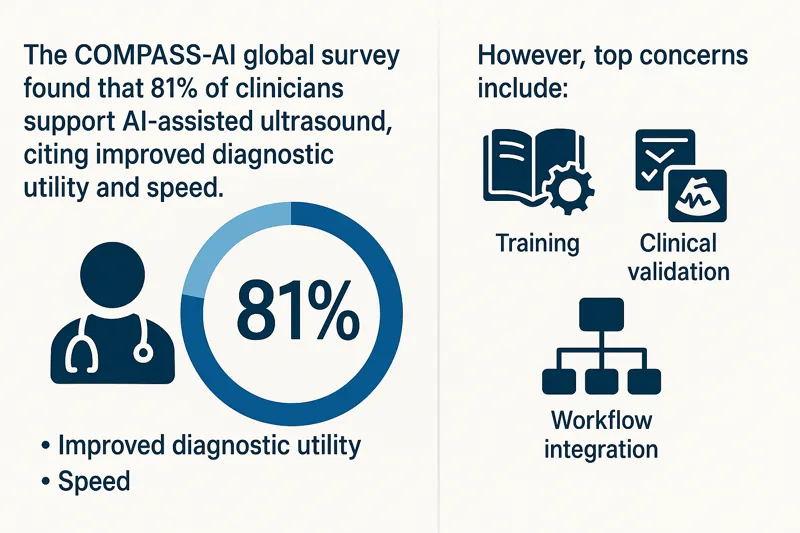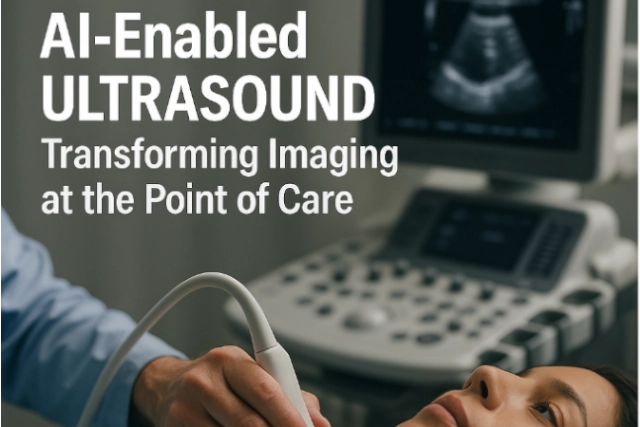In today’s fast-paced healthcare environment, ultrasound is increasingly recognized not just for prenatal or cardiac assessment, but as a versatile diagnostic tool across specialties. Now, artificial intelligence (AI) is accelerating ultrasound’s impact — reducing operator dependency, improving diagnostic confidence, and enabling faster bedside care. For imaging leaders, especially in rural or underserved settings, AI-powered ultrasound technology paired with teleradiology support offers a compelling path for enhanced access and precision.
Innovations in AI-Ultrasound You Should Know
- FDA Clearance for AI Thyroid Ultrasound
In 2024, See-Mode Technologies received FDA clearance for an AI-powered thyroid ultrasound system that can detect and classify nodules using the ACR TI-RADS scale. It has shown promising results in standardizing reporting and reducing unnecessary biopsies and follow-ups.
Source: https://www.auntminnie.com - Projected Market Growth
The global AI ultrasound market is projected to grow at a compound annual growth rate (CAGR) of 22% through 2029. This rapid growth is fueled by the rising burden of chronic disease, limited radiologist availability, and the push for faster, more accessible diagnostics.Source: https://www.pharmiweb.com/
- Rural Potential with Point-of-Care AI
A JAMA Cardiology viewpoint outlines how AI-assisted point-of-care ultrasound (POCUS) can enable more accurate cardiovascular assessments even when performed by generalists—especially valuable in remote areas without imaging specialists.
Source: https://jamanetwork.com - Clinician Enthusiasm and Challenges
The COMPASS-AI global survey found that 81% of clinicians support AI-assisted ultrasound, citing improved diagnostic utility and speed. However, top concerns include training, clinical validation, and workflow integration.
 Why It Matters for Facilities and Radiology Teams
Why It Matters for Facilities and Radiology Teams
- Reduces staffing burden: AI ultrasound reduces variability among operators, ideal for high-turnover or remote settings.
- Speeds up decision-making: Frontline providers can quickly gather meaningful imaging data, while teleradiologists handle the interpretation.
- Expands imaging reach: Portable, AI-powered ultrasound extends diagnostic capabilities to underserved regions.
- Supports standardization: AI helps standardize image acquisition and reporting, improving overall workflow efficiency.
How Vesta Teleradiology Enhances AI-Ultrasound Value
While AI augments imaging workflows, expert interpretation is still essential. Vesta provides:
- Subspecialty reads across thyroid, vascular, MSK, and more
- 24/7 coverage with fast turnaround times
- Seamless PACS/RIS integration for AI-acquired ultrasound data
Our radiologists help bridge the gap between frontline imaging and specialist analysis—ensuring that every AI-enabled ultrasound scan contributes to timely, confident patient care.
Bringing AI and Teleradiology Together
Whether you’re running a rural health center, a large outpatient clinic, or an emergency department, AI ultrasound paired with expert teleradiology interpretation helps:
- Increase imaging access without compromising accuracy
- Alleviate staffing constraints
- Deliver faster diagnoses
- Improve patient outcomes
AI in ultrasound is not replacing radiologists — it’s helping them focus on what matters most. With Vesta’s support, healthcare organizations can embrace innovation while maintaining high-quality, consistent imaging interpretation.
